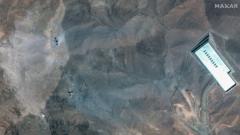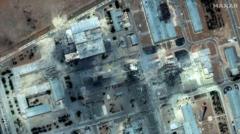Despite claims of a comprehensive victory, the Pentagon suggests that the damage was minimal, allowing Iran to quickly resume its program.
**Pentagon Report Reveals Limited Impact of US Strikes on Iran's Nuclear Program**

**Pentagon Report Reveals Limited Impact of US Strikes on Iran's Nuclear Program**
A recent assessment indicates that the US airstrikes on Iran's nuclear facilities did not significantly hinder the country's nuclear ambitions.
The recent airstrikes conducted by the United States on Iranian nuclear installations have raised questions about their effectiveness, as a Pentagon intelligence evaluation concludes that the strikes did not dismantle Iran's nuclear program. According to sources familiar with the assessment by the Defense Intelligence Agency, rather than being obliterated, Iran's nuclear capabilities were only set back by a few months.
The strikes targeted three key facilities: Fordo, Natanz, and Isfahan, employing advanced "bunker buster" bombs designed to penetrate heavy concrete and secure infrastructure. However, the official report indicates that the core of Iran's enrichment capabilities, particularly its centrifuges, remained largely undamaged. Many aboveground structures were affected; notably, entrances to two of the facilities were sealed, and some equipment was either damaged or destroyed.
Significantly, it has been revealed that portions of Iran's enriched uranium stockpile were relocated prior to the attacks, suggesting that the country had anticipated potential aggression and had taken precautions to safeguard vital materials. The airstrikes, rather than being a decisive blow, may only have provided a temporary delay in Iran's nuclear ambitions.
The White House has rejected the Pentagon's assessment, declaring it "flat-out wrong" and a deliberate attempt to undermine the administration's defense policies. President Trump previously asserted that the strikes resulted in a complete destruction of Iran's nuclear capacities. As tensions between the US and Iran continue, the question remains as to how quickly Iran can recover its nuclear program and what the implications will be for regional stability and international diplomacy moving forward.
The strikes targeted three key facilities: Fordo, Natanz, and Isfahan, employing advanced "bunker buster" bombs designed to penetrate heavy concrete and secure infrastructure. However, the official report indicates that the core of Iran's enrichment capabilities, particularly its centrifuges, remained largely undamaged. Many aboveground structures were affected; notably, entrances to two of the facilities were sealed, and some equipment was either damaged or destroyed.
Significantly, it has been revealed that portions of Iran's enriched uranium stockpile were relocated prior to the attacks, suggesting that the country had anticipated potential aggression and had taken precautions to safeguard vital materials. The airstrikes, rather than being a decisive blow, may only have provided a temporary delay in Iran's nuclear ambitions.
The White House has rejected the Pentagon's assessment, declaring it "flat-out wrong" and a deliberate attempt to undermine the administration's defense policies. President Trump previously asserted that the strikes resulted in a complete destruction of Iran's nuclear capacities. As tensions between the US and Iran continue, the question remains as to how quickly Iran can recover its nuclear program and what the implications will be for regional stability and international diplomacy moving forward.



















